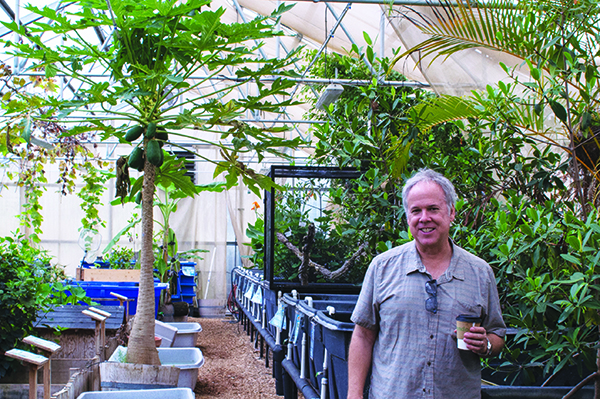
Gary Bagnall, Zoo Med Laboratories founder, in a company greenhouse in San Luis Obispo, California.
Zoo Med at 40
Article & Images by Gary Bagnall
Introduction by Michael J. Tuccinardi
Excerpt from AMAZONAS, November/December 2017
Anyone who has taken part in an aquarium society event in the United States is probably familiar with Zoo Med Laboratories—they donate a wide array of aquatic products to support clubs across the country. But few in the hobby realize that the founder and president of Zoo Med, a leading manufacturer of products for reptiles and amphibians, is himself a lifelong aquarium hobbyist. Gary Bagnall, in addition to being an unabashed and enthusiastic fish geek, has a personal interest in keeping the aquarium hobby thriving and ensuring that national and regional aquarium clubs and societies can continue their work. He has devoted a significant amount of his own money and resources to this cause, and he maintains an impressive collection of rare fishes among the more prominently featured turtles, lizards, and frogs at Zoo Med’s headquarters in San Luis Obispo, California.
Zoo Med is currently celebrating its 40th year in business, and we had the distinct honor of having Gary Bagnall—an unsung hero of the aquarium hobby—share an inside look at the history of the company and some of his personal aspirations for the future.
—M.J.T.

The company founder in the early years with a Shingleback Skink.
A Peek behind the Curtain:
My first decades with Zoo Med Labs
Forty years is a long time for any business to survive—especially a privately held family operation—but this is not where my story begins. I came from a family of four boys. Unfortunately, as a child my younger brother had a number of medical issues, so I was mostly left to my own devices and imagination. Like many budding aquarists, I spent hours down at the local creek in Sacramento, California, exploring the native fishes and lizards and trying to figure out how to bring most of them home. Although I shared a room with my little brother, who was something of a neat freak, I continued to fill my half of the room with an ever-growing assortment of aquariums, terrariums, and fishbowls.
When I was 11 years old I got my first job, at a pet shop (Russo’s Wonderful World of Pets in Newport Beach, California), earning the impressive starting salary of 50 cents per hour. I loved every minute of it, and by the age of 13 my focus had narrowed to tropical fishes. Yes, I was bitten by the tropical fish bug (we called it hobby pox), and I drowned myself in fish literature and caught rides with my friends to all the local aquarium shops. During this time, the owners of Russo’s asked me to start an aquarium society, so the Newport Fashion Island Aquarium Society, which included world-renowned killifish expert Royal Ingersoll, was born.
I spent many hours collecting local native fishes (both freshwater and marine) and selling them to local aquarium shops. Some of the fishes I found back then were the Desert Pupfish (Cyprinodon macularius) and Sailfin Mollies (Poecilia latipinna) that lived in the Cleveland Canal near the Salton Sea. The mollies became established there when a fish wholesaler who was in business in the 1940s tried to see if raising tropical fishes in the desert was viable (apparently it wasn’t, as he went out of business). Our most famous customer at Russo’s was the actor John Wayne, and I helped him many times when he came in to look at dogs.

A pet-store education: selling puppies and helping John Wayne: Gary at 13 with his Old English Sheepdog “Zig-Zag.” This was a 1969 ad for Russo’s Wonderful World of Pets- the first pet shop I worked at, starting at age 11.
As it happened, I went to one of the two schools in the United States that taught offset printing at a high school level, so we actually printed our aquarium club newsletter on my high school’s ATF Offset Chief 15 printing press—with photographs, which was unheard of at the time. The owner of a new local aquarium store wanted to run ads in our aquarium newsletter and asked me to come visit; when I arrived, he showed me a price list of African Cichlids (all Latin names, of course) and asked if I knew what these fishes were. I said yes, and he offered me a job. I replied, “Only if I can be the manager,” because I was tired of Russo’s treating me like a child. Thus began my final aquarium job leading up to the start of Zoo Med. The store was called Southwest Pet Center; it eventually started selling purebred dogs and birds. On a good weekend we sold over 40 dogs! Curt Lorenz was one of the smartest business owners I had ever met, and he taught me the power of advertising. He always wanted to be the first to offer an unusual pet. We had a miniature horse, a pot-bellied pig, an ostrich, and many other animals that were seldom seen in pet shops. I actually took the miniature horse for a walk one day and decided I was hungry, so the horse and I walked into a McDonalds and I ordered lunch. The crew at the counter didn’t know what to say, but I got my lunch without any problems.
Adventures in the import/export trade
When I was 19, a friend of mine who worked with a tropical fish wholesaler in Los Angeles was quitting to open a store in San Diego. I applied for his job and got it. Now I was selling tropical fishes in both Orange County (where I lived) and San Diego County. I refused to allow the crew at the wholesaler pack fishes for my customers, so I drove to Los Angeles each night to do it myself and was back on the road the next day selling more fishes. I was only getting about three hours of sleep per night, and one night I was so tired I dropped a bucket of 200 Neon Tetras from the top of a ladder. I quickly retrieved them, but this made me think, “This job is going to kill me!” So on my fish route I started selling live reptiles, which all my customers had been asking for, and I was so successful that in 1977 I quit the fish-selling job and started a live import/export reptile company, which later became Zoo Med Labs, Inc.
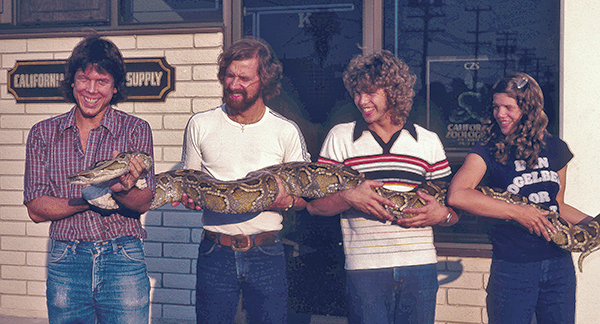
Photo taken in 1979 in front of the first warehouse California Zoological Supply rented—before this we were in garages. Left to right: Gary, Lloyd Lemke (accomplished Elaphe snake breeder), Ed Kammer (Parson Chameleon breeder), and Mandy.
The first name of my company was In Cold Blood (after the 1966 Truman Capote best-selling book of the same name) because reptiles are ectotherms (cold-blooded). When I picked up my shipments of live reptiles from the freight terminals in Los Angeles, the workers at the receiving desk did not share my humor (“I’m here to pick up reptiles for In Cold Blood…”), so I changed the name to Orange County Zoological Supply and eventually to California Zoological Supply. I spent my twenties traveling all over the world, procuring reptiles for Cal Zoo.
I traveled to Honduras, Mexico, Suriname, Ghana, Sierra Leone, Nigeria, Western Samoa, and Egypt. The king of Western Samoa signed our paperwork to export Pacific Island Boas and Coconut Crabs, and I was the first person to import Egyptian Uromastyx lizards and Egyptian Tortoises from Egypt. Cal Zoo also brought in the first four albino Boa Constrictors from Colombia, from which all albino and albino morphs in the pet trade are descended. I loved traveling and immersing myself in the live reptile business, but one day something odd happened.

This ad to
promote our terrarium
cage disinfectants
featured a surfing
iguana.
From livestock to dry goods
One of Cal Zoo’s good customers was a man named Mike Verner, who would put P.T. Barnum to shame. Mike was a genius at self-promotion and ran an aquarium and reptile shop that was second to none. His shop was one of the first to offer fully set-up vivariums with arrow frogs in them, and he sold setups that looked like something straight out of the Amazon rainforest. One day Mike walked into Zoo Med, placed a bottle of his ReptiVite reptile vitamins on my desk, and asked if I wanted to sell them. I laughed and said, “Who’s going to buy reptile vitamins?” I’ve never forgotten his reply: “Gary, vitamins don’t die, they don’t defecate, and they let you go home on weekends.” Now, anyone in the live animal business knows that the hours are very long—as in 12+ hours per day, 7 days a week. Live animals do not know when it’s a weekend or a holiday; they must be cleaned, watered, and fed every single day.
I agreed to try to sell the vitamins, and that is how Zoo Med started. Pet shops quickly embraced this product, and soon they were asking for more reptile products. It didn’t take long for me to buy out Mike’s business (excellent bird and reptile vitamins), and I quickly added reptile posters, driftwood, the Log Cabin Terrarium and Aquarium (a hollowed-out tree trunk with a window added to make a small terrarium or fishbowl), and a line of foods we made in-house. We developed the Reptile Rock Heater, which mimicked a place where a lizard or snake would come to heat up its intestines in order to digest its dinner. We made this product ourselves, from winding the coil-heating element to mixing the cement. We even made special ovens to cook moisture out of the stones and accelerate the drying.

A keystone product in the building of Zoo Med: revolutionary UVB-emitting bulbs for reptiles
1993 was a big year for Zoo Med—we developed the very first UVB reptile lamp in the world. I got the idea from a former Cal Zoo employee, Jil Whitcomb, who was raising juvenile green iguanas at the time. Some people just have a gift with animals, and Jil was one of them. She kept her iguanas in an open wire cage for airflow, provided arboreal structures so they could climb, fed them the correct diet, and provided a range of temperature zones, including a hot basking site. She even kept the cage next to a glass sliding door to capture indirect sunlight.
Everything seemed perfect, but at the age of eight months all the iguanas starting losing muscle mass in their hind legs and perished a month or so later from metabolic bone disease. Iguanas are major sun-basking lizards in the wild, and I had a hunch that regular glass was filtering out the benefits of sunlight. My research confirmed this, and I also discovered that what these animals were missing in captivity was the ultraviolet B (UVB) component in sunlight. If you looked all over the world for a UVB lamp in 1993, you would find it in only one place—the United States. The lamp was designed for the indoor suntanning industry; now I had to figure out how I could apply this type of lamp to reptiles. After researching UVB safety and the way reptiles process UVB/Vitamin D3 in their bloodstreams, we produced our first reptile UVB lamp, the ReptiSun UVB 310.
Milestone Inventions
When the lamp went to market in 1993, nobody understood why they needed it and why it cost more than conventional lights, so we had very poor sales the first year, despite an extensive education program. Our competition quickly produced knockoffs, but because they had little or no understanding of the physics of our lamp, they simply stuck reptile UVB lamp stickers on their aquarium lamps. For the next trade show we designed a light box into which we put every company’s reptile UVB lamp. Using a UVB meter, we showed customers at our booth that our lamp was the only one that put out any significant amount of UVB.
Other milestones for Zoo Med in the 1990s were our new line of reptile foods in retorted cans, ReptiBark substrate, basking heat lamps, natural grass iguana foods, a natural mite remedy, ReptiSafe water conditioner, and the first canned insects for the reptile industry (Can Os). In 2000, my fish hobbyist gene could not stand it any longer, and we added a full line of aquarium lamps. We came out with floating Turtle Docks in 2003 and made sure we had a patent, as this turned out to be a great product for Zoo Med and even won product of the year from one of our largest customers. Some of the other products in this decade were an automatic misting machine (ReptiRain), an automatic live bug catcher (BugNapper), Vita-Sand (substrate), and floating turtle and aquarium logs.
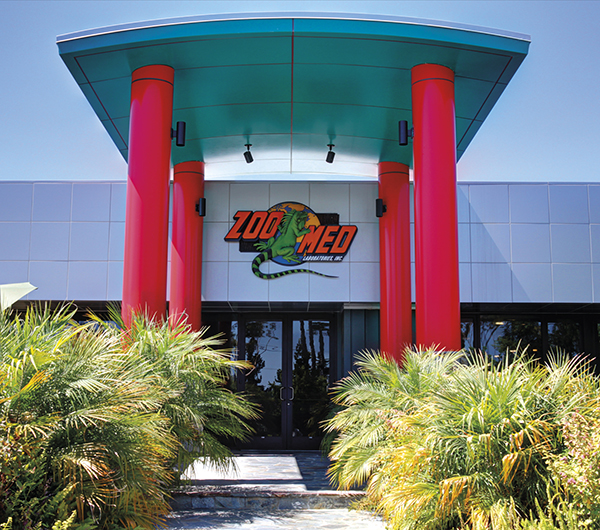
Company headquarters in 2017.
At one point Zoo Med had 16 warehouses in San Luis Obispo County, partly because we grew and partly because our small town did not have any buildings large enough to house our business. We finally moved into the 140,000-square-foot warehouse we have today, and another 60,000-square-foot building offsite.
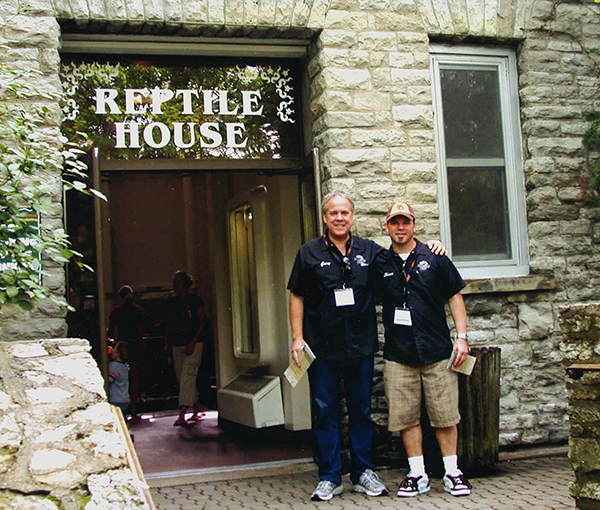
Gary and his nephew Shane Bagnall in front of the Reptile House at the Cincinnati Zoo during one of the many Zoo conferences we attend.
Pet Nirvana
Being a hobbyist myself, I like to surround myself with like-minded serious enthusiasts and animals. Zoo Med’s customer service people are unique in that they are all hobbyists and use phone headsets while taking customer service calls so they can simultaneously maintain our company collection of rare turtles, tortoises, tropical fishes, and amphibians. In fact, in 2009 we built a 3,000-square-foot greenhouse we call Turtle Nirvana that is home to all our breeding stock of aquatic turtles and tortoises. This state-of-the-art greenhouse is heated by geothermal energy and has temperature-controlled UVB-transmitting glass panels on the roof. We have another 1,200 square feet of grow-out tanks for hatchling turtles, our tropical fish collection (we breed some cichlids), and our amphibians. We also have a special room where we incubate all our eggs in Zoo Meds Reptibators. We currently house over 500 turtles, 80 tortoises, 125 lizards, and 25 amphibians. Since 2009 we have successfully hatched over 1,500 animals from 47 species, many of them endangered.
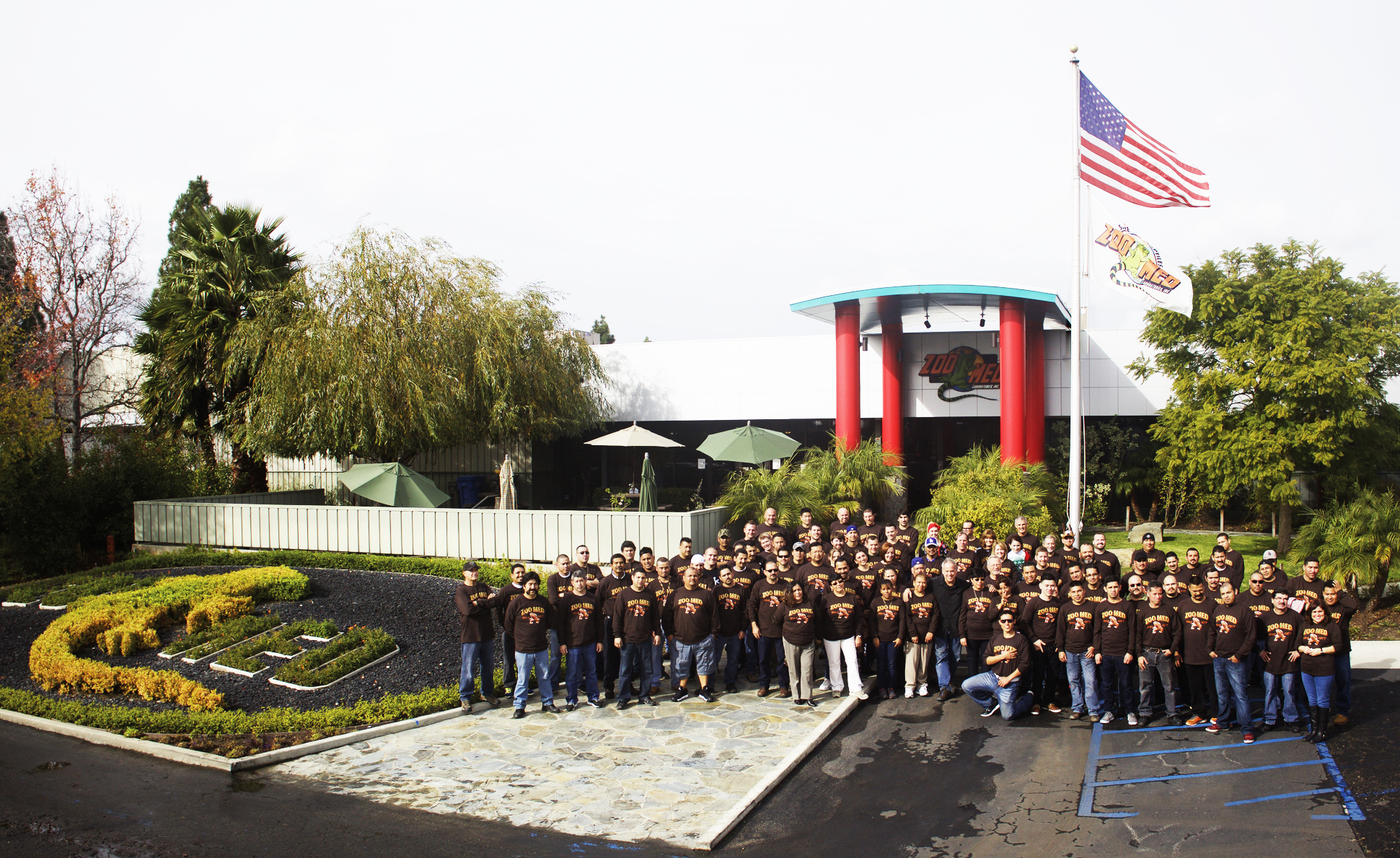
Zoo Med staff, fall 2017, in San Luis Obispo.
Zoo Med might not have made it to 40, and would not be the company it is today, without a number of key people. They say you can count your closest friends on one hand, and Zoo Med’s COO, Steve Dalrymple, is one of mine. We met when we were 15 years old and have remained friends and business colleagues ever since. Steve has worked at Zoo Med for 25 years and is part of the R&D team.
Another crucial member of the team is Ken Fontes. When I met him in 2003, I was so impressed with his character and business acumen that I hired him on the spot. Ken became our CFO, controller, and director of human resources, and he significantly improved the quality of our workforce. My nephew, Shane Bagnall, one of the leading UVB researchers in the world, worked as a biological engineer at the prestigious Salk Institute in La Jolla, California, before coming to Zoo Med over 15 years ago.
Last but not least is Rita Zarate, whose immigrant parents worked hard to put all four of their children through college; Rita came to Zoo Med with a master’s degree in international business. She is part of the new guard who will take Zoo Med into the future long after I am gone.
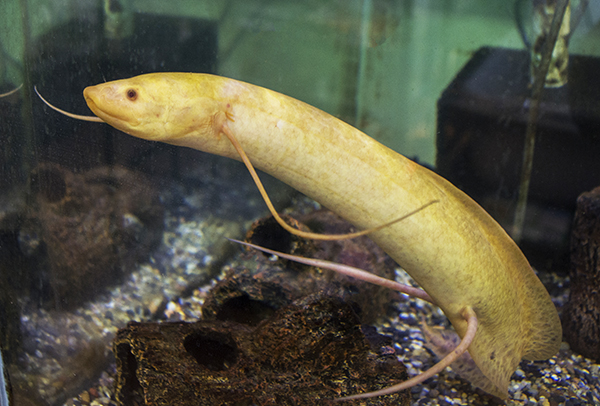
My Albino African Lungfish (Protopterus a. aethiopicus). I have always loved “prehistoric”-type fishes.
So what now? I could not be more proud of this company, which started 40 years ago in a one-car garage with a $300 investment. My dream for the next decade is to construct a Reptile Zoo and a pet and aquarium museum that tells the history of petkeeping from the mid-1800s to today. In the meantime I still help develop new products for Zoo Med, travel to aquarium and reptile shows, and eat a Paleo diet, as I may need to live to 100 to finish all the work (and fun) I have to do!
Part II: Vintage Aquariums
Coming in the January/February Issue of AMAZONAS
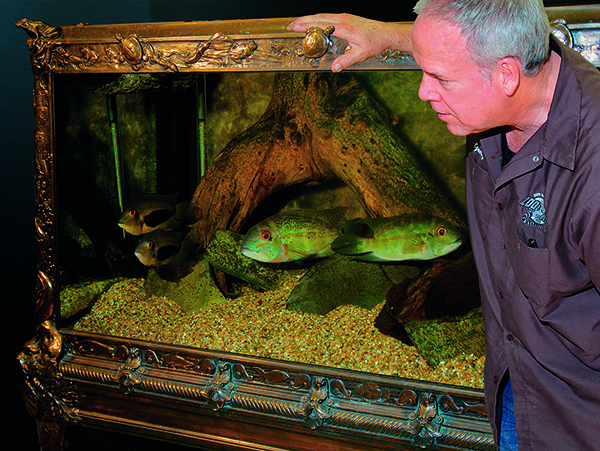
Gary Bagnall with one of his extensive collections of vintage and historic aquariums, to be featured in the next issue of AMAZONAS.






We are export dealer of tropical aquatic ponds water plans and exotic fish from Africa,